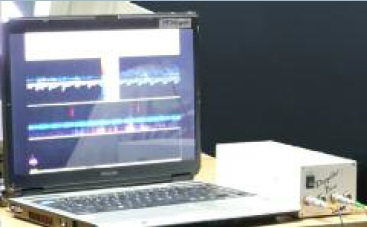➣ By Beatriz Rey et al.

Figure 1. Screen capture of the virtual environment used in the experiments.
In order to study the psychological mechanisms underlying experiences in virtual environments (VE), one of the concepts that are analyzed is presence. A commonly accepted definition of this concept indicates that presence is the subjective experience of being in one place, even when you are physically located in another.
One of the possible indicators of presence that have been proposed is neurological activity. Brain activity measures are promising because they potentially provide data that is not influenced by the participant’s interpretation. However, the analysis of these measures can be difficult since very little is known about the neural processes that are involved in the complex experience of presence. The brain activity measures that have been proposed for presence research are the electroencephalogram (EEG) and the functional magnetic resonance imaging (fMRI).
An alternative brain activity measurement technique has been proposed recently: Transcranial Doppler Monitoring (TCD).
Transcranial Doppler Monitoring
TCD is a technique of diagnosis by ultrasound. It requires two probes to be placed on the head of the subject using a headband or a similar object. It allows us to directly register the information of blood flow velocity from the Middle Cerebral Artery (MCA), Anterior Cerebral Artery (ACA) and Posterior Cerebral Artery (PCA). The probe direction, the reference volume depth and the flow direction identify each cerebral artery.
TCD has important advantages when compared to other techniques. First of all, it has a high temporal resolution, which allows instantaneous monitoring of cerebral responses to specific events. Furthermore, it is non-invasive, so it is possible to use it in an ecological way in a great variety of environments. That constitutes its main advantage when compared with other techniques such as fMRI. The main disadvantage of TCD is its spatial resolution, which is limited by the size of the cortical areas supplied by the arteries under study.
TCD has been widely used to monitor cerebral hemodynamics during the performance of cognitive tasks in psychophysiological research. These studies have shown that mean BFV obtained from TCD signals increases when users are doing a cognitive activity when compared to baseline periods.

Figure 2. The Transcranial Doppler unit used in the experiments (Doppler-Box Compumedics Germany GmbH) is connected to a PC in which BFV signal can be visualized.
TCD and Presence
We have used TCD to analyze cognitive states related with presence during the exposure to VE in different immersion and navigation conditions.
In the first study, two different navigation conditions were compared (user-controlled vs. system-controlled navigation). The percentage variations between baseline and navigation were positive in all the arteries under study (MCAs and ACAs). Significant differences occurred only in the left arteries. The variations in MCA-L could be due to the motor tasks with the right hand to control the joystick. However, the variations in ACA-L can only be explained by other factors such as differences in the emotional state or the level of presence that the user is experiencing during the VE exposure in the different navigation conditions. Presence questionnaires confirmed that the level of presence was different between experimental conditions.
The second study compared the same navigation conditions but in two different immersion configurations (CAVElike vs. projection screen). In this case, only MCAs were considered. The navigation factor had significant influence in BFV variations in both MCA.
Discussion
The studies that have been described show that it is possible to use TCD monitoring during exposure to VE. TCD is a tool that can be easily integrated in VR settings to monitor brain activity during the VR experience, so it is possible to obtain reliable TCD signals during the exposure to VE. On the other hand, the use of TCD does not interfere with the capability of the subjects to focus their attention on the VE.
Further research may contribute to discern the role of each variable in the differences in the blood flow velocity that have been observed in these studies.
Beatriz Rey, Ph.D.
Mariano Alcañiz, Ph.D.
Universidad Politécnica de Valencia
Vera Parkhutik, Ph.D.
Jose Tembl, Ph.D.
Hospital Universitari La Fe
Spain
brey@labhuman.i3bh.es
www.labhuman.com
About Brenda Wiederhold
President of Virtual Reality Medical Institute (VRMI) in Brussels, Belgium.
Executive VP Virtual Reality Medical Center (VRMC), based in San Diego and Los Angeles, California.
CEO of Interactive Media Institute a 501c3 non-profit
Clinical Instructor in Department of Psychiatry at UCSD
Founder of CyberPsychology, CyberTherapy, & Social Networking Conference
Visiting Professor at Catholic University Milan.









